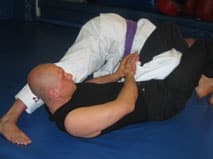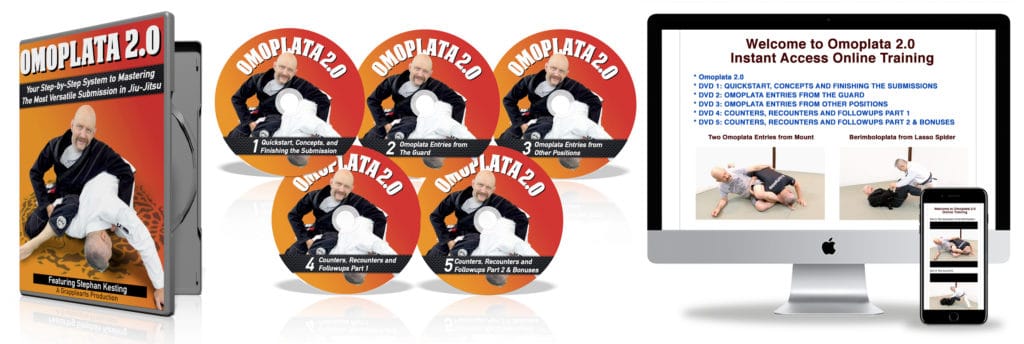I was first exposed to something resembling the omoplata when learning a martial art known as Indonesian Silat from Dan Inosanto. A move where you use your leg to bend your opponent’s arm behind his back is often used in Silat as a finishing move after taking someone to the ground.
It turned out that this move (with slight modifications) also worked in the jiu-jitsu and judo training that I was doing at the time. It really started working for me and for a short time I thought that I was the first person to ‘discover’ this technique in a grappling context.
Whoops, was I ever wrong.
First I came across a VHS tape of a jiu-jitsu competition in Brazil in which lots of black belt competitors were using the omoplata on each other. OK, so they knew about it in Brazil.
Then I came across a rare book – Vital Judo by Isao Okano – which also had pictures of people using their legs to apply a twisting armlock to finish their opponents (‘Ashi Sankaku Garami’ in Japanese). This book had been published in 1976, proving that some Japanese Judoka had known about it for quite some time already!
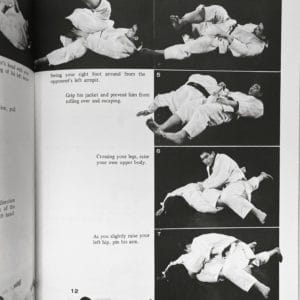
Omoplata or Ashi Sankaku Garami in the Vital Judo book
It was a little bit discouraging to find that I wasn’t the inventor of this move, but the fact that many high level grapplers were endorsing and using this technique suggested that I was on the right track.
Now that I knew the technique had a name I kept exploring the position. I even started hitting it in competition, mostly as a sweep, where my opponents were pretty baffled by it…
I’m pretty sure this is the first Omoplata I ever hit in competition, either in 1999 or 2000.
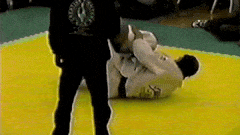
My first omoplata in competition
I hit the entry hoping for a submission then converted to a log roll sweep with the underhook to get to the top position.
Once on top I used a very rudimentary variation of the Sitting on Shoulder position to immobilize him, then tried to move to the Kesa Gatame pinning position and finally to side control. If I recall correctly I finished the match with a cutting arm lock on his far (right) arm from knee mount.
Had I had a more refined Sitting on Shoulder position I could have had more control and finished the match much earlier though. To start with I should have folded my left calf underneath his left arm to more effectively pin it and free up my arms. The goal from the Sitting on Shoulder is to squeeze his upper biceps and triceps area with a paper cutter movement so hard that it cuts off circulation to his hand and forearm.
I didn’t know them back then, but from there you have many different ways to move directly into a submission (e.g. the Monoplata, far side armlocks, rolling Omoplatas that destroy his posture or end you up in the crucifix.). Anyhow, I’m grateful that somebody was filming this. With the giant direct-to-VHS cameras available at the time it’s a miracle that there’s any footage at all.
Anyway, now that the omoplata was working regularly in class and in competition I dug deeper with my experimentation and research. I wanted to share some of these discoveries with my friends from out of town, so I got my hands on a giant camera that filmed directly onto a VHS cassette mounted on the side, filmed my musings, and then sent the cassette out to them in the mail. We would email or call to share our thoughts about the technique.
Around that time it also became a little easier to get your hands on competition footage, which allowed me to study how it was being used in high level competition around the world.
And finally people were starting to talk about it online, and if you were really lucky they’d post tiny little pictures which would take forever to load.
Eventually all this research ended up in an article called ‘Revolutionary Omo Plata‘ which I published in the now defunct ‘Grappling Magazine.’
The reaction to that article was so good that I took the bull by the horns and in 2003 published a 2 volume VHS cassette instructional called ‘Omo Plata and the Dynamic Guard.’
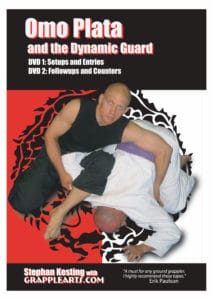
The original Omoplata and the Dynamic Guard
This instructional now seems incredibly dated when I look at it. The cinematography, editing, and teaching are all very early-2000’s. And I was so damn determined to be ‘professional’ that not the slightest sense of humour leaked through in the instruction at all.
People liked it though, and they posted kind reviews about it on places like the Underground Forum and the NHB Gear Forum. This was an encouraging sign, and ended up leading to other instructional projects, building Grapplearts out as a gigantic website, youtube channels, social media profiles, and all the rest of it.
It’s now been 19 years since I first published Omoplata and the Dynamic Guard. But that wasn’t the end of my journey with this technique; I’ve continued using it, researching it, adding new techniques and details, getting rid of outdated tactics, and improving my teaching skills.
(After all, having a ton of knowledge in your head is worthless if you can’t communicate it effectively to other people).
Despite the high mileage on a 52 year old body my omoplata transitions and combinations were looking better than ever. The material was looking good and the people I was teaching really liked it.
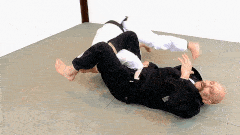
Rolling omoplata escape countered by a brief inversion
Finally it was time to unleash a much improved omoplata instructional into the world. Bigger, better, and more informative.
And now after quite literally decades of research and many months of writing, filming and editing the new instructional, Omoplata 2.0, is finally ready.
To start with, here’s a quick 53 second preview of what’s in the instructional…
In Omoplata 2.0 we first cover the specific concepts that turn mediocre Omoplata attacks into great Omoplata attacks. These concepts will help make the techniques much more effective and easier to remember.
Then we have a very detailed entries section that’ll give you 41 different ways to get into this submission. This includes both entries from the guard and entries from the top position no matter what kind of resistance you get from your opponent.
Then we cover the “Sitting on Shoulder” position in a ton of detail. It’s amazing how often high level guys use this position transitionally when spinning and twisting all over the place.
Learning the Sitting on Shoulder is really a huge piece of the puzzle when it comes to mastering the Omoplata attack; it’ll help you develop that advanced flow to carry your attack forward no matter what the other guy does.
Finally we’ll do a deep dive into the secret sauce of making any submission work: teaching all the counters you’re likely to run into AND how to systematically shut them down and succeed with your attack.
Many of these techniques and tactics haven’t been been taught before, and certainly not in such an organized and logical layout.
This material has been percolating in my mind for years and I’m so glad it’s now available in online streaming, app and DVD form. Please check it out if you have a moment!
Thanks ever so much
Stephan
P.S. First of all, did anyone notice how many Omoplata armlocks and sweeps there were at the BJJ World’s this year? There really was a whole lotta plata going on, proving that this technique just keeps on being relevant.
P.P.S. Click here to find out more about the Omoplata 2.0 instructional, available in DVD, online streaming, and app based formats.
The post The 20 Year History of the Omoplata 2.0 Instructional appeared first on Grapplearts.

